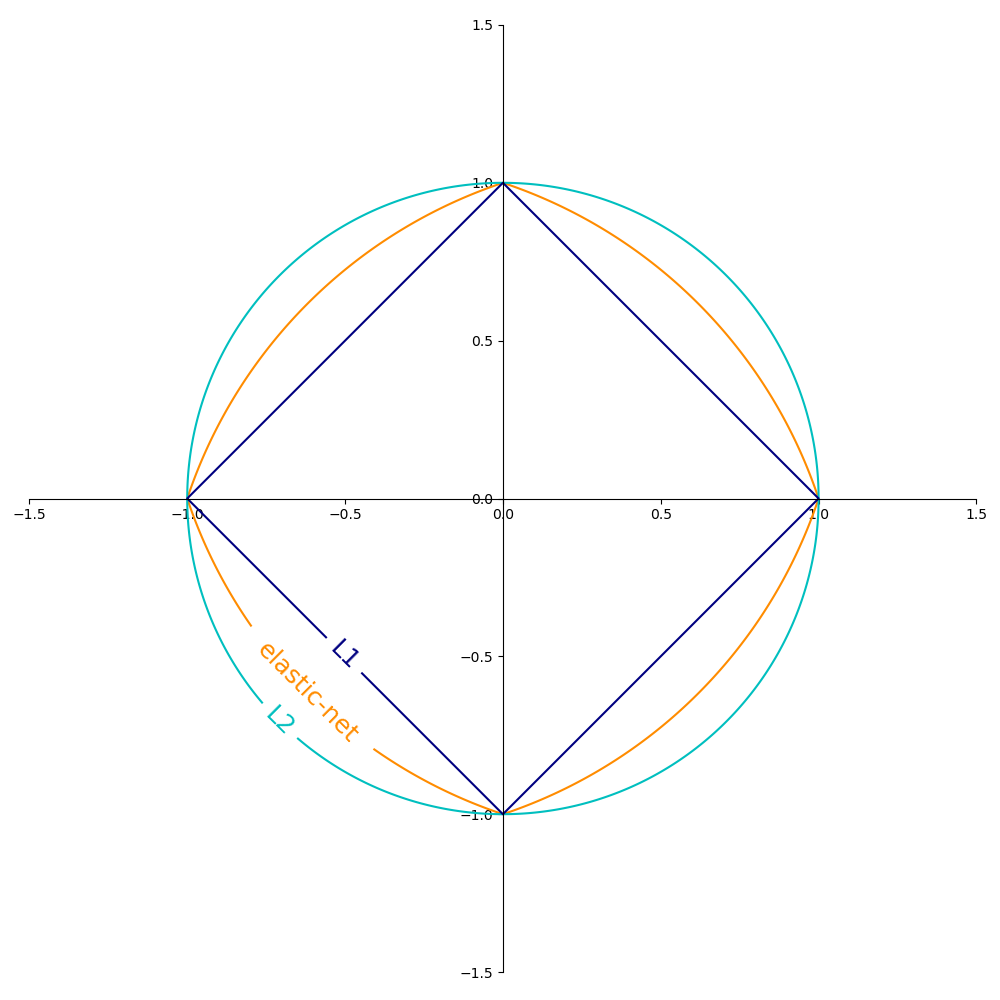Plot the contours of the three penalties.
All of the above are supported by sklearn.linear_model.stochastic_gradient.

from __future__ import division
print(__doc__)
import numpy as np
import matplotlib.pyplot as plt
def l1(xs):
return np.array([np.sqrt((1 - np.sqrt(x ** 2.0)) ** 2.0) for x in xs])
def l2(xs):
return np.array([np.sqrt(1.0 - x ** 2.0) for x in xs])
def el(xs, z):
return np.array([(2 - 2 * x - 2 * z + 4 * x * z -
(4 * z ** 2
- 8 * x * z ** 2
+ 8 * x ** 2 * z ** 2
- 16 * x ** 2 * z ** 3
+ 8 * x * z ** 3 + 4 * x ** 2 * z ** 4) ** (1. / 2)
- 2 * x * z ** 2) / (2 - 4 * z) for x in xs])
def cross(ext):
plt.plot([-ext, ext], [0, 0], "k-")
plt.plot([0, 0], [-ext, ext], "k-")
xs = np.linspace(0, 1, 100)
alpha = 0.501 # 0.5 division throuh zero
cross(1.2)
l1_color = "navy"
l2_color = "c"
elastic_net_color = "darkorange"
lw = 2
plt.plot(xs, l1(xs), color=l1_color, label="L1", lw=lw)
plt.plot(xs, -1.0 * l1(xs), color=l1_color, lw=lw)
plt.plot(-1 * xs, l1(xs), color=l1_color, lw=lw)
plt.plot(-1 * xs, -1.0 * l1(xs), color=l1_color, lw=lw)
plt.plot(xs, l2(xs), color=l2_color, label="L2", lw=lw)
plt.plot(xs, -1.0 * l2(xs), color=l2_color, lw=lw)
plt.plot(-1 * xs, l2(xs), color=l2_color, lw=lw)
plt.plot(-1 * xs, -1.0 * l2(xs), color=l2_color, lw=lw)
plt.plot(xs, el(xs, alpha), color=elastic_net_color, label="Elastic Net", lw=lw)
plt.plot(xs, -1.0 * el(xs, alpha), color=elastic_net_color, lw=lw)
plt.plot(-1 * xs, el(xs, alpha), color=elastic_net_color, lw=lw)
plt.plot(-1 * xs, -1.0 * el(xs, alpha), color=elastic_net_color, lw=lw)
plt.xlabel(r"$w_0$")
plt.ylabel(r"$w_1$")
plt.legend()
plt.axis("equal")
plt.show()
Total running time of the script: (0 minutes 0.078 seconds)
Download Python source code:
plot_sgd_penalties.py
Download IPython notebook:
plot_sgd_penalties.ipynb
Please login to continue.